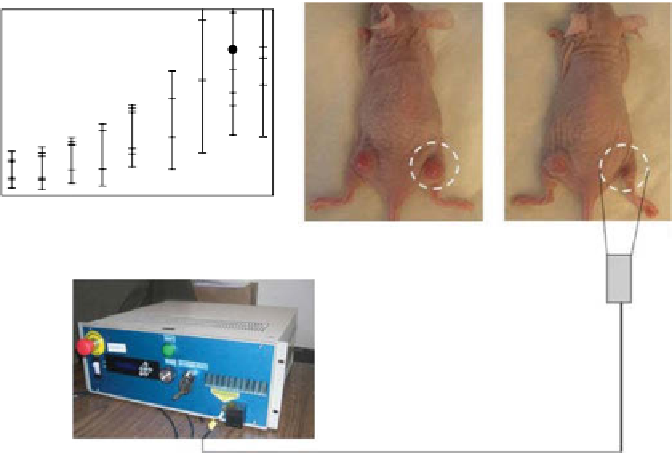Biomedical Engineering Reference
In-Depth Information
7
Nanorods-laser
Nanorods+laser
Saline-laser
Saline+laser
6
5
4
3
2
1
0
0
5
10 15
Time (days)
20
25
Saline
Nanopartz gold nanorods
Fiber-optic
probe
Laser
FiGure 12.2
In published mouse studies, the shown system has demonstrated efficacy in
destroying MdA-MB-435 breast cancer tumors. In this example, tumors were grown in two
mice. In mouse A (left), PBS was injected, whereas in mouse B (right), Nanopartz gold
nanorods were injected. After 72 h, a 2 W 808 nm diode laser was used to photothermally treat
the cancer areas. For the Nanopartz-treated mouse, the tumor was completely destroyed and
no mass remained after 12 days.
drug and oxygen delivery, and, most importantly, increases vessel porosity allowing
enhanced delivery of nanoparticle therapeutics.
In this effort, we evaluated the use of polyethylene-coated AuNRs as a potential
cancer therapy and imaging device—one that couples intravenously injected
Nanopartz polyethylene-coated AuNRs with an external laser to heat and poten-
tially ablate cancer tumors in companion animals with soft tissue sarcomas. Our
initial efforts have shown success in mice in a preclinical study (Fig. 12.2) and,
more recently, canines in an Ohio State University clinical trial [9, 10]. In this
chapter, we demonstrate the results of imaging and treating sarcomas in companion
animals.
12.2
BackGround
12.2.1
history of Thermal ablation
Throughout history, hyperthermia has been an accepted method of cancer treatment
in humans, either alone or as a secondary therapy in concert with another method.
One example of enhanced therapeutic benefits offered by hyperthermia is found in
the treatment of head and neck cancers; using standard radiation techniques, the



























Search WWH ::

Custom Search